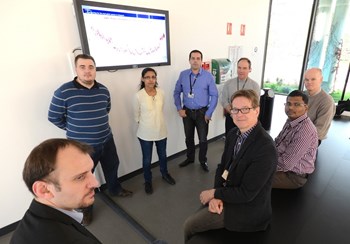ITER NEWSLINE
-
What's on TV?
R.A.

The co-producers—in order, from left to right: Xavier Mocquard, Nicolas Pons, Supriya Nair, Joël Hourtoule (Electrical Power Distribution Section leader), Gilles Consolo, Anders Wallander (CODAC Division head), Mahesh Khedekar and Petri Makijarvi.
A new series is being broadcast live on the TV screen installed in the lobby of the ITER Headquarters.
Co-produced by
CODAC and the ITER Electrical Power Distribution Section the series' script, automatically written in real-time, tells the story of how power consumption on the ITER site and in the Headquarters building varies every few seconds.
Despite the action being a bit repetitive—it's all about coloured graphs rising and falling—the making of the series represents a good example of co-acting between CODAC and the ITER "electricians."
"What you see onscreen is a simple demonstration that we can collect, process and archive signals in accordance to CODAC procedures," explains Anders Wallander, head of ITER Control and Systems Division, and Joël Hourtoule, Electrical Power Distribution section leader.

When construction and assembly activities peak in the coming years, ITER electricity needs will be in the range of 10 to 15 MW—equivalent to those of a small town.
The real-time information and the daily and monthly recaps are of crucial importance to support the electrical power network; they will also be very useful when electricity contracts will be negotiated. The data collected, according to Anders, is also "a metric of ITER construction progress."
When construction and assembly activities peak in the coming years, ITER electricity needs will be in the range of 10 to 15 MW—equivalent to those of a small town. The 100 MW mark will be passed when plants systems (such as cryogenics, cooling water, vacuum, building services, heating systems and magnets power supplies) are all "plugged in" to produce steady-state plasmas inside the ITER Tokamak.
return to the latest published articles








